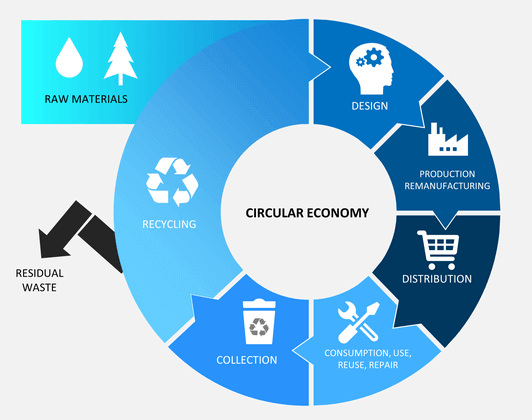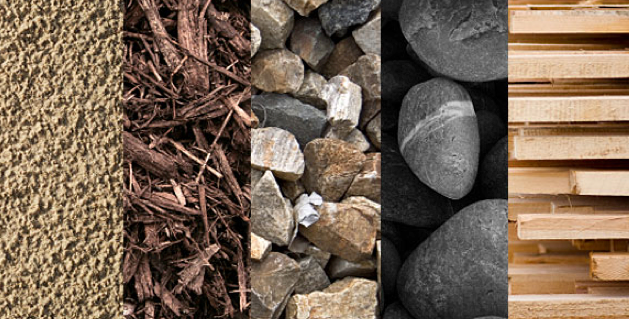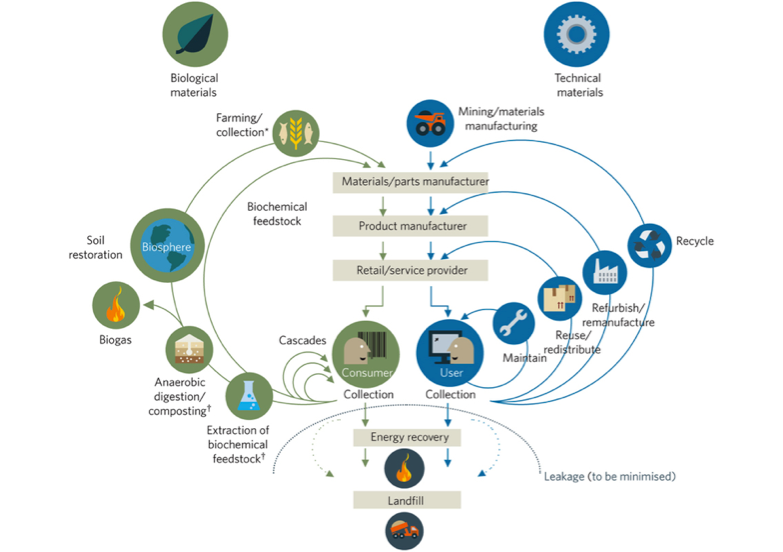di Chiara Catgiu
A linear economy, that extracts resources at increasing rates, according to the principles of take-make-dispose, without consideration of the environment in which it operates, cannot continue indefinitely. The concept of a circular economy promises a way out. Here products do not quickly become waste, but they are reused to extract their maximum value before safely and productively returning to the biosphere.1
Materials play an essential role in circular economy. By designing products with materials that come from, and safely flow, into their respective nutrient cycles, they can be part of creating an optimized materials economy that eliminates the concept of waste.2
Not long ago, materials selection was considered a small part of the design process. The selection of a material for a specific purpose is a lengthy and expensive process. Approximately always more than one material is suitable for an application, and the final selection is a compromise that brings some advantages as well as disadvantages. Material selection is an interdisciplinary effort and it often requires different fields of study such as material science and engineering, mechanical engineering, industrial engineering and other experts in the field of application.3
 Traditionally, materials selection for the design of facilities is based on economic and technological considerations, given the desired life span of a facility and the program of requirements and codes it must meet.
Traditionally, materials selection for the design of facilities is based on economic and technological considerations, given the desired life span of a facility and the program of requirements and codes it must meet.
In design environments where ecological, health, and ethical impacts are increasingly important, often the only way to choose from many different material alternatives is by relying on experience and observation. In selecting materials, designers have to take into account a large number of factors, including sustainability, durability, recyclability and materials impact on environment.
A sustainable material or a sustainable resource is something whose production is supported indefinitely by nature, which means, a resource is used up at the same speed that it is renewed. From the moment the raw materials are extracted to the moment the final product is disposed of, there must be no permanent damage to the environment.4
By integrating environmentally sustainable materials into design projects, it is possible to significantly reduce environmental impacts through less energy consumption, less natural resource depletion and pollution, plus less toxicity for both the occupants and the entire ecosystem.
These both minimize the negative impacts on the environment and occupants whilst maximizing positive impacts over the lifecycle of a design facility. But little research has yet focused on designers’ choices of sustainable materials and those that have demonstrated on the whole that sustainable materials selection is not a priority.5
The circular economy illustrates a model, by operating in many different ways, which suggests:
- Tight inner circles where minimum new materials are used before materials can be re-used, refurbished or re-manufactured. Such products offer the greatest savings in terms of embedded costs, materials, energy and labor. They also offer the greatest savings on environmental effects or externalities such as emissions to air, land or water, including reducing greenhouse gas emissions;
- Circles of use where the number of times materials can be used through consecutive circles is increased. Re-use, remanufacture or recycling is used to achieve this objective;
- Cascade use, where materials are recovered, re-engineered and cascaded into new uses from that originally envisaged. Good examples are recovered plastics used as insulation materials rather than packaging or cotton cascaded into a series of uses once it is no longer suitable for recovery and re-use in clothing;
- Pure circles, where uncontaminated materials are returned for re-use in primary manufacturing. 6
This type of research will continue, as society understands the potential to use secondary materials from waste as a primary source for new design products, in a completely circular economy model.
1 E. M. Foundation, “Towards the Circular Economy,” 2013.
2 E. M. Foundation, “The Circular Design Guide,” 2016.
3 A. Jahan et al., “Material Screening and Choosing Methods – A Review,” Materials and Design, vol. 31, pp. 696–705.
4 M. F. Ashby, “Materials Selection in Mechanical Design”, Third edit. 2005.
5 C. S. Hayles, “Environmentally sustainable interior design: A snapshot of current supply of and demand for green, sustainable or Fair Trade products for interior design practice”, International Journal of Sustainable Built Environment, vol. 4, pp. 100-108.
6 ISWA, “Circular economy: trends and emerging ideas”, 2015.






